The jackalberry (Diospyros mespiliformis), also known as African ebony, is a large deciduous African tree found mostly from Senegal and the Sudan right down to Namibia and the Northern Transvaal. The tree is part of the Ebenaceae family. It commonly grows on savannahs or in savannah woodlands. Jackals are fond of the fruits, which explains its common name.
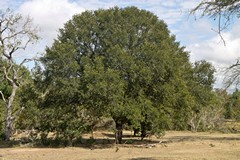
Mature specimen of a jackalberry in
Selous Game Reserve
The tree prefers moist soil, and rocky soils. It grows well in red loams, volcanic and loamy sands. jackalberry trees are also commonly found along river beds. It often grows on termite mounds. In heavy soils the termite mounds provide the tree with aerated soil, and a source of moisture. The roots provide protection for the termites, who don't eat the living wood. Jackalberry wood is almost termite-resistant after it has been cut down.
The jackalberry tree can grow up to 25 metres, with a trunk circumference of 5 metres. However, heights of 6 metres are more usual. They have a rounded crown, which is densely foliated. The mature trunks from older and heavier trees have fluted, flattened ridges along the trunk which buttress and strengthen them. The bark is dark brown when young, turning dark grey as it matures and has a rough texture, forming deep longitudinal fissures.
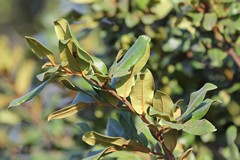
The single glossy green leaves are elliptical
and wavy along the edges
Leaves are elliptical in shape, up to 15cm long and 7 cm wide with smooth or wavy edges. Older leaves are more glossy, and have a leathery look, darker green above and a lighter green below. Young leaves and twigs are covered with downy hairs. Young trees are evergreen, but older ones will shed their leaves in Spring. New leaves will grow from June to October and can be pinkish, orange or reddish in color. The leaves are eaten by elephants, rhinos, giraffes, buffalos, and kudus. The larvae of the bushveld emperor butterfly also eat the leaves of this tree.
Jackalberry flowers are small but fragrant. White to pale cream hairy flowers are separate genders, growing on different trees. The females grow singly on a hairy stalk while the males grow in clusters. The tree flowers during the rainy season, and bears fruit in the dry season. only female trees produce fruit.
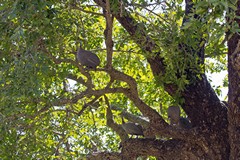
Helmeted Guniea fowl in a jackalberry. You
can see some young fruits in the top left and
right hand corners of the photo
The fruit is eaten by many animals including kudus, nyalas, impalas, warthogs, baboons, parrots, and hornbills. The fleshy fruit is oval, almost round in shape and about 1 inch in diameter and yellow or yellow-green in colour, becoming purple if it is left on the tree long enough to mature. Two to six seeds are found inside the fruit.
Seeds are dispersed either through wash-off by rain or in the droppings of animals that feed on the fruits.
The skin of the fruit is tough but it is edible by people. Fruits have a floury consistency with a lemony flavor. They can be eaten fresh or preserved. They are also dried and ground into flour. A beer and a type of brandy is also brewed from them.
Wood is hard, and very strong, and almost completely resistant against termites. The heartwood is fine-grained and good for floors, and high quality furniture. It varies in color from light, reddish brown to almost black.
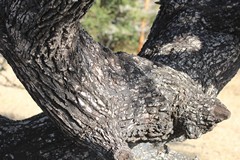
The dark grey bark develops longitudinal
fissures with age
The trunks are used to make canoes.
It has various uses in traditional medicine. Tanin is contained in the leaves, bark and roots, and acts as an astringent that helps stop bleeding. The tree is also supposed to have antibiotic substances within it that help to heal wounds. A mixture made from the roots is used get rid of parasites like ring worm, and the leaves and bark are said to be capable of cureing dysentery and fever. They are also considered to be a remedy for leprosy as well as being good for treating wounds.
Different insects such as bees and wasps play a role in pollinating the flowers. The tree benefits from moisture and aeration as a result of termites burrowing in the soil under it. Snakes like to reside close to or around the tree as they prey on the rodents and birds that feed on the fruits.
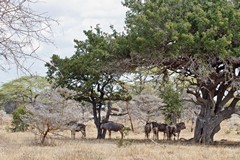
A small herd of Mozambique wildebeestes
take shelter from the hot sun under the
spreading and dense canopy of a jackalberry
Another benefit from the jackalberry tree is the flavour it allegedly gives to termites nesting around it. The termites feed on the roots and humans eat the termites, including flying termites, which are supposed to be delicious.
You are welcome to try them, and let me know what you think.